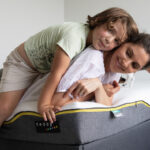What is Montessori?

The facts about this ‘alternative’ education style – could it be right for your child?
The Montessori method of learning is having something of a moment, which has many parents asking, what is it? Here’s what you need to know.
Most Australians educate our kids in the same way that our parents educated us: play and/or preschool, followed by kindy/primary and secondary education. The majority of us send our toddlers out on their learning journey through a local government or privately run preschool or kindy, without even realising there are other learning methods and options out there.
Something of an ‘alternative’ method of learning – in that it doesn’t exclusively follow the Australian National Curriculum – Montessori is a private school option that might suit your child and your family.
So, what is the Montessori Method, and how do you know if it’s right for your child?
The Montessori Method
The Montessori Method of learning was devised by Italian doctor and educator, Maria Montessori who opened her first school in 1907. So this way of learning isn’t new!
Through her medical study in psychiatry and her interest in education, Montessori identified a way to engage children by letting them take lead in specially designed classrooms. By appealing to their natural curiosity and their desire to learn, this ground-breaker’s method saw previously unruly young kids learning to prepare meals, working out games and puzzles and ‘teaching’ themselves based on their environment. And thriving!
The Montessori way of learning is based, first and foremost, on respect for the child, and is often referenced as treating the child like an adult by encouraging independence. The ‘classroom’ is a prepared environment that supports independent exploring and learning.
The 5 main areas of Montessori learning
There are five main pillars of Montessori learning, and they all embrace the idea of the four Cs: critical thinking, collaboration, creativity, and communication. This style of learning is very hands-on, and allows children to learn through doing – practical experience – rather than being ‘told’ and then being expected to remember and repeat facts ‘parrot fashion’. Briefly, the five main areas of the Montessori curriculum are:
- Practical life (preparing food, cleaning up – being part of an adult world)
- Sensorial (using the five senses to explore and learn)
- Mathematics (often using beads to count with in the early stages)
- Language (using phonics – the sounds of letters and words)
- Cultural studies (georgraphy, science, art and music, for example)

What are the school grades or years in Montessori
Montessori education is multi-age and is generally broken down into the following learning stages:
- Infants – 8 weeks to 18 months
- Toddlers – 18 months to three years
- Children – 3 to 6 years
- Elementary – 6 to 12 years
- Secondary – 12 to 18 years
The classrooms may also accommodate three different age groups, depending on the size of the classes and the school, and the needs of the children. Class sizes in Montessori tend to be smaller than traditional classrooms, with 10-15 students in the younger stages. According to Montessori advocates, multi-stage classrooms have proven “effective not just in academics but in developing strong social and emotional skills”.

How do I know if Montessori is right for my child?
Understanding the foundations of a Montessori education might help you decide if it’s the right path for your child.
This educational philosophy focuses on helping each child learn and grow at their own pace, guided by the educators in areas that the child is drawn to. It encourages self-learning and builds on a little one’s natural instinct to take an interest in the world around them.
It’s important to note that kids who start out in a Montessori school don’t necessarily finish their education the same way. Take note that Taylor Swift attended a Montessori school for two years.
Is Montessori a good option for my ADHD child?
A Montessori education promotes patience and caters to each child’s unique learning style and pace. In this respect, this type of learning may be a good option for kids with ADHD. Fostering self-directed learning, building practical life skills and developing self-esteem are just some of the benefits, according to the Montessori Academy.
What are the negatives of Montessori learning?
Montessori schools are private facilities, which means there may be sizeable fees attached. They not as common in Australia as state-based schools, meaning that even if you want to educate your child this way, there might not be a school close by. Independent learning and the open-ended nature of the classroom isn’t for every child; many prefer structure and routine that help to create boundaries and reinforce expectations.

How many Montessori schools are there in Australia?
There are approximately 360 Montessori schools and centres across Australia. Compare this so the 9,614 state schools, as of 2022. There is only one higher education provider in Australia where students can train to become Montessori educators – the Montessori Institute.
Do Montessori kids follow the national curriculum?
Yes. While Montessori schools have their own curriculum (the five main pillars, mentioned above), they are required to follow the Early Years Learning Framework and the Australian National Curriculum. This includes NAPLAN for the relevant age groups, and may include HSC and IB for older students.
Is Steiner the same as Montessori?
No Steiner (or Waldorf) schools are not the same as Montessori. They are based on different methods. For example, kids in Montessori may start learning to read from the age of three. In Steiner, kids begin learning to read and write around the age of 7. Prior to that, talking, stories, singing and poetry are prioritised.
Famous people who had a Montessori education:
- Taylor Swift
- Beyonce Knowles
- Jess Bezos (Amazon Founder)
- George Clooney
- Dakota Fanning




